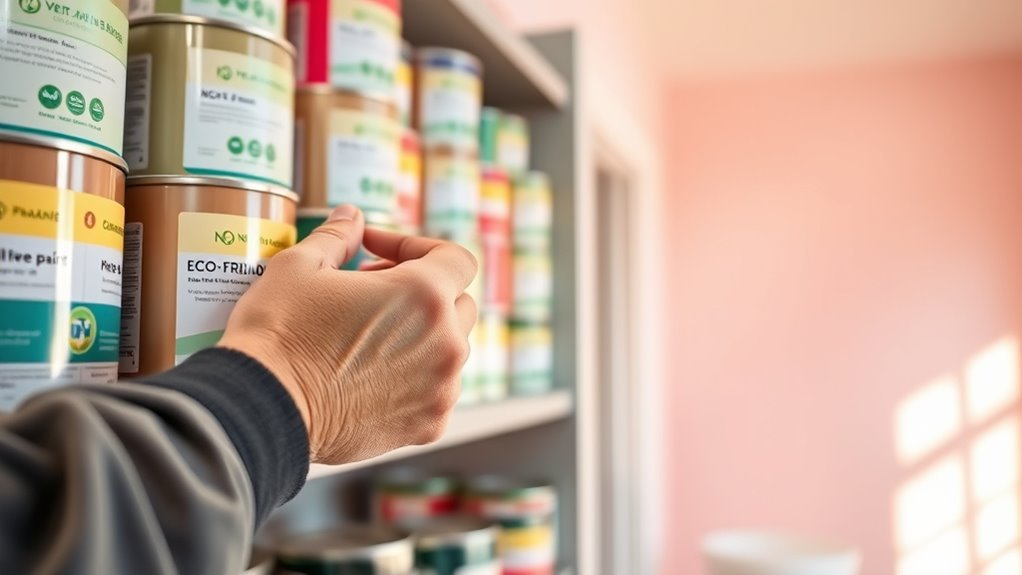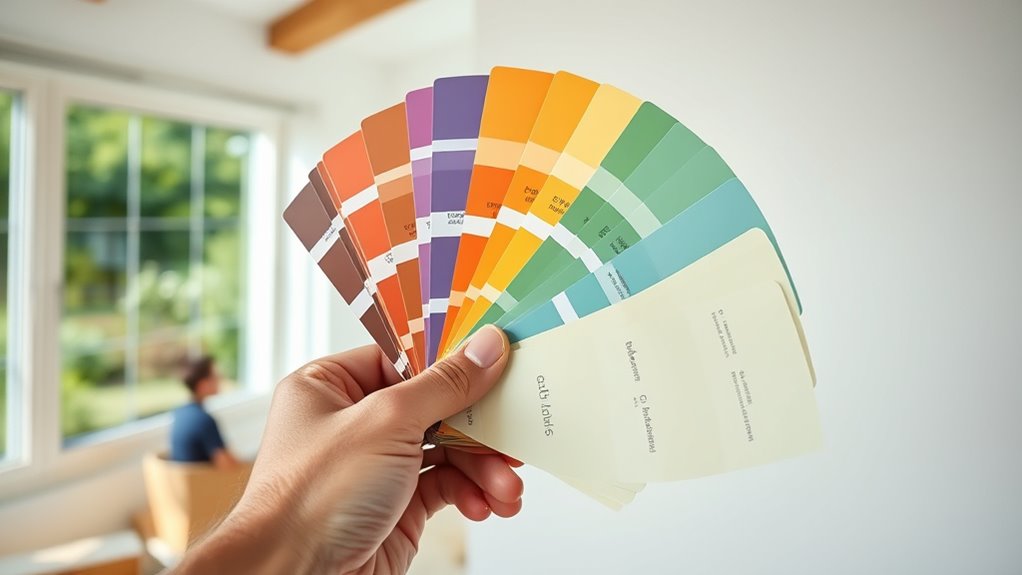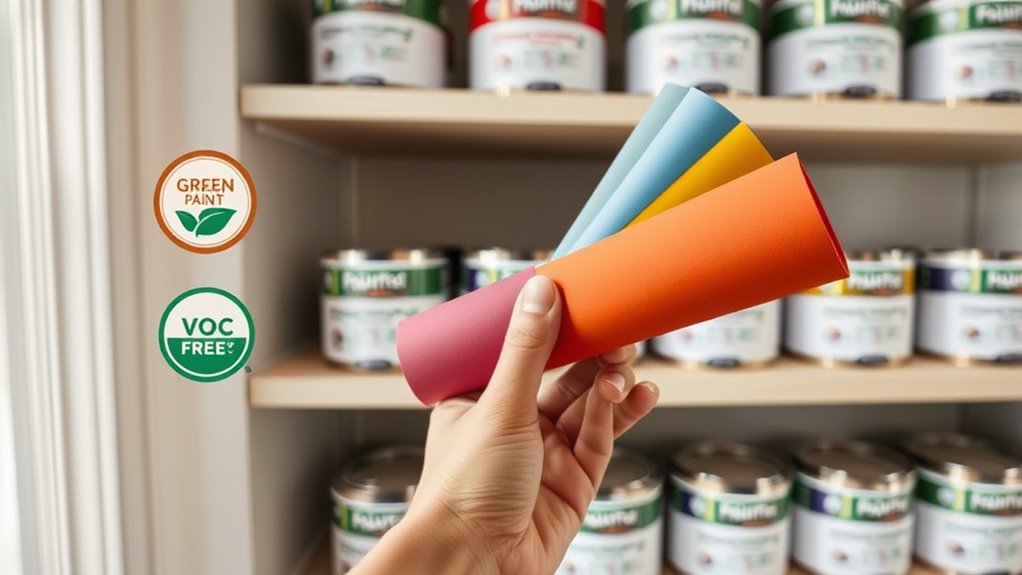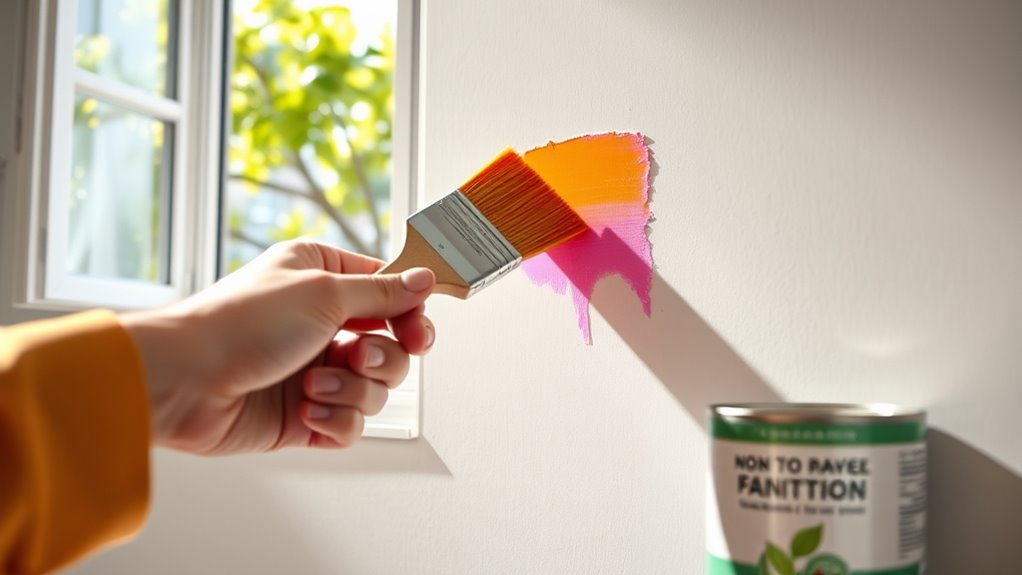To select non-toxic paints for healthier indoor spaces, look for options with low or zero VOC content and natural pigments from minerals or plants. Check for trusted certifications like Green Seal or EcoLogo, which guarantee reduced chemical emissions. Ventilate well during and after painting by opening windows and using fans to speed up fumes’ dissipation. Knowing these tips can help you make safer choices for your home and well-being — continue to explore for more helpful insights.
Key Takeaways
- Look for low VOC and VOC-free paints with eco-friendly certifications like Green Seal or ECOLOGO.
- Check labels for natural pigments derived from minerals or plants, avoiding synthetic dyes.
- Read product labels to ensure absence of solvents, formaldehyde, heavy metals, and artificial chemicals.
- Ventilate well during and after painting by opening windows and using fans or air purifiers.
- Choose reputable brands committed to sustainability, transparency, and using non-toxic, natural ingredients.
Understanding the Benefits of Non‑Toxic Paints

Understanding the benefits of non-toxic paints is essential when choosing the right product for your home. These paints markedly reduce VOCs, or volatile organic compounds, which are harmful chemicals released into the air during and after painting. Lower VOC levels mean less chemical smell and fewer health risks for you and your family. Improved indoor air quality is one of the key advantages, creating a safer, healthier environment. Non-toxic paints help minimize respiratory issues, allergies, and sensitivities caused by airborne toxins. Additionally, many non-toxic paints are made with eco-friendly materials, reducing environmental impact. By choosing these paints, you not only protect your indoor air but also contribute to a cleaner, more sustainable home. It’s a simple step toward healthier living spaces where you and your loved ones can breathe easier and enjoy comfort without chemical worries.
Key Ingredients to Look For and Avoid

When choosing non-toxic paints, paying close attention to key ingredients can make a significant difference in ensuring safety and health. Look for low VOC paints, as volatile organic compounds can off-gas harmful fumes over time. These paints release fewer toxins, helping improve indoor air quality. Additionally, consider products made with natural pigments, which are derived from minerals, plants, or other non-toxic sources, avoiding synthetic dyes that may contain harmful chemicals. Avoid paints with solvents, formaldehyde, and other volatile chemicals known to cause health issues. Reading labels carefully helps you identify safe options. By prioritizing low VOC paints and natural pigments, you’re taking essential steps toward creating a healthier indoor environment for your family. Proper ventilation during and after painting also plays a crucial role in reducing residual fumes and ensuring a safer indoor space.
Identifying Certifications and Labels

Looking for certifications and labels on paint containers can help you quickly identify products that meet safety and environmental standards. Certifications like Green Seal or ECOLOGO indicate VOC reduction, ensuring lower emissions of harmful volatile organic compounds. Look for labels that specify the use of natural pigments, which are less likely to contain toxic chemicals. These labels often highlight that the paint has been tested for low odor and minimal off-gassing, contributing to healthier indoor air quality. By paying attention to these certifications, you can avoid products with high VOC levels and artificial additives. HEPA filtration and other effective technologies in air purifiers demonstrate the importance of choosing products that promote cleaner indoor environments. Remember, trusted labels provide assurance that the paint aligns with your goal of creating a safer, non-toxic environment. Always read labels carefully before making your selection.
Tips for Applying and Ventilating Non‑Toxic Paints

To guarantee the safest and most effective results when applying non-toxic paints, proper ventilation is essential. Start by opening windows and using fans to circulate fresh air during and after painting. This helps disperse fumes and reduce lingering odors. When applying paint, use smooth brush techniques to minimize splatter and ensure even coverage. Hold your brush at a consistent angle and avoid pressing too hard, which can cause uneven application. After painting, continue ventilating the space for several hours or until fumes dissipate completely. If possible, use exhaust fans or air purifiers to enhance airflow. These ventilation strategies, combined with careful brush techniques, help protect your health and ensure a clean, safe environment during your painting project. Additionally, understanding the sound vibrations used in sound healing can inspire calming auditory environments that promote overall well-being in your space.
Choosing Eco-Friendly and Safe Brands

How can you guarantee you’re choosing the safest paint brands? Start by looking for companies that prioritize eco-friendly practices. Choose brands that use natural pigments, which are free from synthetic chemicals and toxins. Check for VOC free formulas, ensuring no volatile organic compounds that can harm indoor air quality. Read labels carefully—trustworthy brands clearly state their ingredients and avoid heavy metals or artificial dyes. Research brands committed to sustainability and transparency, as they often produce safer, non-toxic paints. Consider certifications like Green Seal or EcoLogo, which verify eco-conscious manufacturing. Additionally, selecting paints with glycolic acid benefits can contribute to healthier indoor environments by reducing harmful emissions. By selecting these brands, you reduce exposure to harmful chemicals, creating a healthier environment for your home and family. Making informed choices helps you enjoy beautiful, safe walls without compromising your health.
Frequently Asked Questions
How Long Do Non-Toxic Paints Typically Last Before Needing Repainting?
The repainting timeline for non-toxic paints usually ranges from 5 to 10 years, depending on factors like paint durability, the room’s usage, and environmental conditions. You can expect these eco-friendly paints to maintain their appearance for a long time if you take good care of your walls. Regular cleaning and avoiding harsh scrubbing help extend their lifespan, meaning you won’t need to repaint as often, keeping your interiors fresh and healthy.
Are There Specific Colors That Are More Environmentally Friendly in Non-Toxic Paints?
You might wonder if certain colors are more eco-friendly in non-toxic paints. Generally, colors made with natural, eco-friendly pigments tend to be better for the environment and indoor air quality. While vibrant shades may sometimes use more synthetic dyes, softer, earth-tone colors often have improved color longevity and are created with sustainable ingredients. So, choosing hues with eco-friendly pigments not only benefits the environment but also helps maintain your paint’s durability over time.
Can Non-Toxic Paints Be Used on Outdoor Surfaces Effectively?
Imagine your outdoor walls standing tall against storms, sun, and time—yes, non-toxic paints can do that! They’re designed for outdoor durability, boasting impressive UV resistance that keeps colors vibrant and surfaces protected. You can confidently use non-toxic paints on outdoor surfaces, knowing they’ll withstand the elements without harmful fumes or chemicals. Just choose high-quality options, and your outdoor spaces will stay beautiful and safe for years to come.
What Are the Best Storage Practices for Leftover Non-Toxic Paint?
You should store leftover non-toxic paint in airtight storage container types like metal or plastic cans to keep it fresh. Make sure to label the containers clearly and keep them in a cool, dry place away from direct sunlight. Proper paint disposal is essential once you’re done. Never pour leftover paint down the drain, and check local regulations for safe disposal or recycling options to prevent environmental harm.
Do Non-Toxic Paints Require Special Cleaning Tools or Techniques?
Think of cleaning your brushes with non-toxic paints like gentle dancing—less harsh, more precise. You don’t need special tools, but thorough cleaning with warm water and mild soap works best. For spill cleanup, act quickly to prevent stains. Regular brushes work fine, but avoid harsh chemicals. By treating your tools with care, you keep your environment safe and your paints in top shape, making every project a breeze.
Conclusion
By choosing non-toxic paints, you create a healthier space where every breath feels cleaner. As you roll the brush across your walls, imagine the fresh, pure air filling your home, free from harmful fumes. With mindful selection and proper ventilation, you turn your walls into a sanctuary of safety and serenity. It’s a small step that makes a big difference—transforming your living space into a haven where wellness and comfort naturally align.









